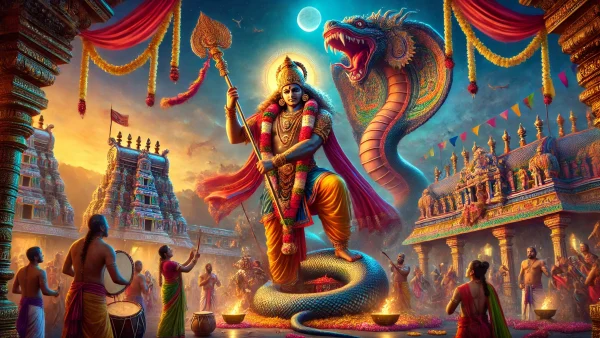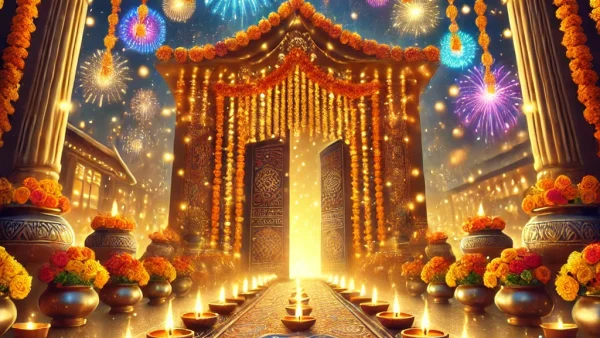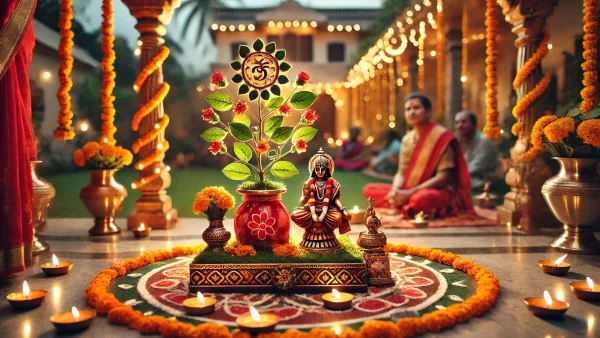Diwali, also known as the Festival of Lights, is one of Hinduism’s most celebrated and cherished festivals. It spans five days, each carrying its unique traditions, significance, and spiritual symbolism. These five days together represent the triumph of good over evil, light over darkness, and knowledge over ignorance. Let’s journey through each day to better understand the spirit of Diwali and the teachings it imparts.
Table of Contents:
- Introduction to Diwali’s Significance
- Day 1: Dhanteras (Wealth and Prosperity)
- Day 2: Naraka Chaturdashi (Freedom from Darkness)
- Day 3: Lakshmi Puja (Welcoming Abundance)
- Day 4: Govardhan Puja (Celebration of Nature)
- Day 5: Bhai Dooj (Strengthening Family Bonds)
- Closing Thoughts: Diwali’s Timeless Teachings
Introduction to Diwali’s Significance
Diwali is celebrated across India and in many parts of the world where Hindu communities reside. It marks the return of Lord Rama to Ayodhya after 14 years of exile, as well as other stories, such as the defeat of the demon Narakasura by Lord Krishna, and the devotion of Goddess Lakshmi. Through these stories, Diwali encourages us to reflect on our own lives, recognize our inner strength, and embrace virtues such as compassion, resilience, and harmony.
Day 1: Dhanteras – Celebrating Wealth and Prosperity
Significance: Dhanteras, the first day of Diwali, is dedicated to wealth, health, and prosperity. The name itself combines “Dhan” (wealth) and “Teras” (the thirteenth day of the lunar month). On this day, people honor Lord Dhanvantari, the god of Ayurveda, who is believed to bring health and well-being to humanity. The day also reveres Goddess Lakshmi, who bestows wealth and abundance.
Traditions and Practices:
In homes and businesses, it’s common to perform a “Dhanteras Puja” to attract good fortune for the coming year. Families often buy precious metals, such as gold and silver, or household items to symbolize prosperity. This ritualistic purchase acts as a reminder that wealth is not just financial; it’s a blessing that brings joy, health, and fulfillment.
Modern Perspective:
Today, Dhanteras encourages reflection on the true meaning of wealth. With many struggling in a fast-paced world, this day serves as a reminder that prosperity includes happiness, health, and meaningful relationships.
Day 2: Naraka Chaturdashi – Freedom from Darkness
Significance: Naraka Chaturdashi, also known as Choti Diwali, commemorates the triumph of good over evil. The day recalls the story of Lord Krishna defeating the demon Narakasura, freeing the world from fear and suffering. This day teaches that facing and conquering our inner demons—fear, ignorance, and hatred—brings true liberation.
Traditions and Practices:
People often wake up before dawn and apply a mixture of fragrant oils and herbs, known as “Ubtan,” before bathing. This ritual represents cleansing oneself of negativity, symbolizing a fresh start. In the evening, homes are decorated with oil lamps, lanterns, and candles, driving away darkness in a literal and spiritual sense.
Modern Perspective:
Naraka Chaturdashi is a powerful reminder to break free from negative influences. With mental health increasingly prioritized, this day encourages self-reflection and the pursuit of inner peace, inviting us to let go of past burdens and embrace a brighter future.
Day 3: Lakshmi Puja – Welcoming Abundance and Blessings
Significance: Lakshmi Puja is the highlight of Diwali, marking the arrival of Goddess Lakshmi, the deity of wealth and prosperity. The story goes that on this day, Lakshmi roams the Earth, bestowing blessings upon households that invite her presence through cleanliness, light, and reverence.
Traditions and Practices:
Lakshmi Puja involves elaborate offerings of flowers, sweets, and candles to honor the goddess. Homes are meticulously cleaned, and doors are left open, symbolizing the welcoming of blessings. Rangolis (colorful patterns made with colored powders) are drawn at entrances to invite positivity. Families gather for aarti (prayer) and recite mantras, creating a harmonious and spiritually uplifting environment.
Modern Perspective:
Beyond material wealth, this day encourages us to recognize the “abundance” in our lives—health, relationships, and personal growth. By opening ourselves to gratitude and positivity, we create a welcoming space for spiritual wealth to enter our lives.
Day 4: Govardhan Puja – Honoring Nature’s Bounty
Significance: Govardhan Puja, also known as Annakut, celebrates Lord Krishna’s protection of the people of Vrindavan by lifting Mount Govardhan to shield them from torrential rains. This story is symbolic of our dependence on and respect for nature.
Traditions and Practices:
Families prepare a “mountain” of food offerings, symbolizing abundance and gratitude for nature’s gifts. In rural areas, people worship cows, symbolizing Krishna’s life as a cowherd and the agrarian way of life. Govardhan Puja emphasizes that nature provides for all beings, and thus, we have a responsibility to care for it in return.
Modern Perspective:
Govardhan Puja is a reminder to cultivate a respectful relationship with nature. In an era where environmental issues are pressing, it calls for conscious living and a commitment to sustainability, aligning with the eco-friendly practices that Hinduism has historically advocated.
Day 5: Bhai Dooj – Strengthening Family Bonds
Significance: The final day of Diwali is Bhai Dooj, dedicated to the bond between siblings. According to legend, Yama, the god of death, visited his sister Yamuna on this day, who welcomed him with love and care. He granted her a boon that any brother visiting his sister on Bhai Dooj would enjoy prosperity and protection.
Traditions and Practices:
On Bhai Dooj, sisters apply a ceremonial tilak (a mark on the forehead) on their brothers’ foreheads, offering prayers for their well-being and success. Brothers, in return, promise to protect their sisters and often exchange gifts. This day celebrates the unbreakable bond of love, trust, and mutual support between siblings.
Modern Perspective:
In today’s busy world, family connections often take a backseat. Bhai Dooj offers an opportunity to reconnect with family, strengthen bonds, and cherish the support system our loved ones provide.
Closing Thoughts: Diwali’s Timeless Teachings
Diwali is much more than a festival of lights. Each of the five days has teachings that resonate with timeless wisdom, urging us to cultivate gratitude, embrace love, respect nature, and connect with those who matter most. For those looking to make Diwali a spiritually enriching experience, incorporating elements like spiritual accessories—such as Rudraksha beads, malas, and sacred Shaligrams—can deepen your connection to the festival. To explore a range of spiritual items, visit spiritualguru.lk and find offerings that can help make your Diwali a truly memorable celebration.
As we light up our homes, may we also ignite a sense of purpose, compassion, and inner peace. Whether you celebrate Diwali traditionally or simply wish to join in the spirit of the festival, its teachings can bring light to anyone seeking joy and clarity in life.







Leave a comment